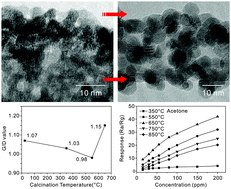Calcination-influenced interfacial structures and gas-sensing properties of multi-walled carbon nanotube–tin oxide p–n heterojunctions
Abstract
Multi-walled carbon nanotube–tin oxide (MWCNT–SnO2) p–n heterojunctions were synthesized using the SnCl2 solution method. The influence of the calcination on the interfacial structure was investigated using scanning and transmission electron microscopy, Raman spectroscopy, X-ray diffraction, thermal analysis, and N2 adsorption–desorption isotherms. The interfacial structure influenced gas-sensing properties were revealed. The heterojunctions calcined at 550 °C under an Ar atmosphere show the strongest interactions between the MWCNTs and SnO2. The strong interactions favored electron transfer, and also resulted in improved gas-sensing properties. After calcination at 650 °C, the increased pore diameter and pore volume, and the improved crystallinity play key roles in the improvement of gas-sensing properties.


 Please wait while we load your content...
Please wait while we load your content...